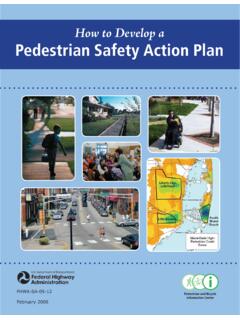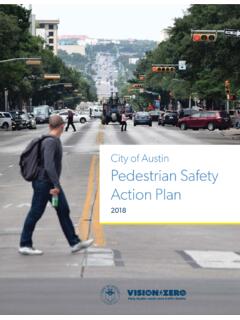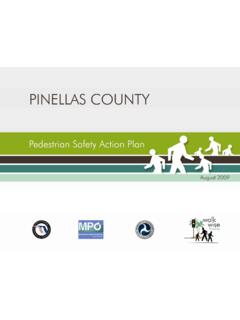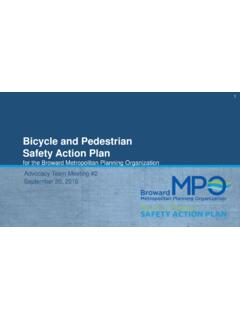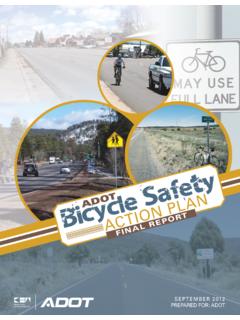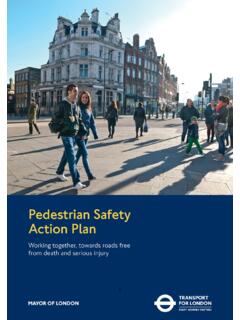Transcription of How to Develop a Pedestrian Safety Action Plan
1 How to Develop aPedestrian Safety Action PlanFHWA-SA-05-12 Revised March 2009 How to Develop a Pedestrian Safety Action PlanFINAL REPORTP repared for:Federal Highway AdministrationOffice of Highway SafetyProject Manager: Tamara RedmonNational Highway Traffic Safety AdministrationProject Manager: Leah PreissPrime Contractor: BMI-SG, a VHB Company Report Authors:HSRC AuthorsCharles V. ZegeerLaura SandtMargaret ScullyConsultant AuthorsMichael RonkinMike CyneckiPeter LagerweyHSRC Student ContributorsHelen ChaneyBastian SchroederEmily SnyderReport Design and Layout: Laura SandtPedestrian and Bicycle Information CenterHighway Safety Research CenterUniversity of North CarolinaCampus Box 3430730 Martin Luther King, Jr. BlvdChapel Hill, 27599-3430 Original: February 2006 Reprint: May 2008 AcknowledgementsThe project team would like to recognize and express appreciation to the numerous individuals who contrib-uted information, case studies, and feedback for the Guide.
2 They include: Dwight Kingsbury, Assistant State Pedestrian /Bicycle Coordinator, State Safety Office, Florida Depart-ment of Transportation. Craig Raborn, Program Manager for Technical Information, Pedestrian and Bicycle Information Center, Highway Safety Research Center, University of North Carolina at Chapel Hill. Charles Crim, Project Development Engineer, Local Roads and Streets, Illinois Department of Transpor-tation. Nancy Okasaki, Transportation Planner, Metropolitan Transportation Commission, San Francisco Bay Area. Gabriel Rousseau, Transportation Specialist, Office of Safety Programs, Federal Highway Administration, Department of Transportation. Elise Bremer-Nei, Supervising Planner, New Jersey Department of Transportation, Office of Bicycle and Pedestrian Programs. Richard Haggstrom, Senior Transportation Engineer, California Department of Transportation. Dave Bachman, Bicycle/ Pedestrian Program Manager, Pennsylvania Department of Transportation.
3 Kohinoor Kar, Transportation Engineer, Traffic HES ( Safety ) Section, Arizona Department of Transpor-tation. Pat Pieratte, Bicycle/ Pedestrian Safety Specialist, Florida Department of Transportation. Ken Kochevar, Safety and ITS Engineer, Federal Highway Administration, California Division. Gerard Soffian, Office of the Director, Signs and Markings, New York City Department of Transporta-tion. Jim Ercolano, Pedestrian Specialist, Pedestrian /Bicycle Program, New York State Department of Trans-portation Headquarters. Cara Seiderman, Project Planner, Environmental and Transportation Planning Division, Community De-velopment Department, City of Cambridge, Massachusetts. Jennifer Toole, President, Toole Design Group, LLC, Maryland. Bill Cowern, Transportation Operations Engineer, City of Boulder. Ron Van Houten, Professor, Psychology Department, University of Western Michigan. Megan Hoyt, Pedestrian Safety Specialist, Pedestrian Program, Seattle Department of Transportation.
4 Erik Landfried, Graduate Researcher, Pedestrian and Bicycle Information Center, Highway Safety Re-search Center, University of North Carolina at Chapel CreditsThe images in this document were provided by a variety of individuals and agencies, including: Dan Burden Cara Seiderman Mike Cynecki Peter Lagerwey Michael Ronkin Ron Van Houten Jim Ercolano and the NYDOT The Pedestrian and Bicycle Information Center Image Library ( )Table of ContentsIntroduction ..1 Chapter 1: Planning and Designing for Pedestrian Safety The Big 2: Involving Stakeholders ..19 Chapter 3: Collecting Data to Identify Pedestrian Safety Problems ..26 Chapter 4: Analyzing Information and Prioritizing Concerns ..38 Chapter 5: Selecting Safety Solutions ..54 Chapter 6: Providing Funding ..117 Chapter 7: Creating the Pedestrian Safety Action plan ..125 References ..133 Appendix A: How to Create and Run an Effective Pedestrian Advisory Board.
5 141 Appendix B: How to Conduct Pedestrian Counts and Behavior Studies ..144 Appendix C: How to Conduct Pedestrian and Motorist Behavior Assessments ..147 Appendix D: List of Funding Sources ..149 Appendix E: Evaluation of a Pedestrian Safety plan ..154 Appendix F: Reference Guide and plan Summaries ..157 Appendix G: Pedestrian -Related Land Use Planning Resources ..169 Appendix H: Checklist for Engineering and Planning Solutions ..171 Appendix I: Checklist for Pedestrian Safety Action plan Elements ..1841 IntroductionIntroductionThe purpose of this guide on How to Develop a Pedestrian Safety Action plan is to present an overview and framework for state and local agencies to Develop and implement a Pedestrian Safety Action plan tailored to their specific problems and needs. A Pedestrian Safety Action plan is a plan developed by community stakehold-ers that is intended to improve Pedestrian Safety in the community.
6 An objective of the guide is to help state and local officials know where to begin to address Pedestrian Safety issues. It is also intended to assist agencies in further enhancing their existing Pedestrian Safety programs and activities, including identifying Safety problems and se-lecting optimal solutions. This guide is primarily a reference for improving Pedestrian Safety through street redesign and the use of engineering countermeasures as well as other Safety -related treatments and programs that involve the whole community. This guide can be used by engineers, planners, traffic Safety and enforcement professionals, public health and injury prevention professionals, and decision-makers who have the responsibility of improving Pedestrian Safety at the state or local level. Pedestrian Safety Problem BackgroundPedestrian crashes and the resulting deaths and injuries are a serious problem on our roadways.
7 In 2004, 4,641 pedestrians were killed in traffic crashes, representing 12 percent of all roadway-related fatalities (National Highway Traffic Safety Administra-tion, 2004). In urban areas, Pedestrian deaths typically represent 25 to 40 percent of traffic fatalities. Approximately 70,000 pedestrians were injured on roadways in 2004, and many of these were severe injuries. While reducing Pedestrian crashes has recently gained increasing priority among some state and local agencies as well as the Department of Transportation (DOT), more efforts and programs are needed to Develop and implement effective strategies to reduce Pedestrian -related injuries and Safety literature reveals a variety of risk factors that influence Pedestrian crashes and severity. For example, Pedestrian crash risk increases on wide roads (four lanes or more) with high motor vehicle speeds and/or volumes. Intersections are more dif-For more crash sta-tistics, see NHTSA s Traffic Safety Facts: 2004 Data, avail-able at In a society that values choice and freedom, people should be able to walk safely, whether for fun and rec-reation, errands, getting to work or school, shop-ping, or other reasons.
8 2 How to Develop a Pedestrian Safety Action Planficult to cross when pedestrians encounter wide crossing distances, wide turning radii, multiple turn lanes, or traffic control that is confusing or complex. Other high-risk factors include drug/alcohol use by motorists and pedestrians, lack of nighttime road-way lighting, and the lack of walkways along roads. Older pedestrians are much more susceptible to serious or fatal injuries because of their frailty, while young children (particularly males aged 5 to 9) are more likely to be struck by a motor vehicle after darting into the street (Campbell, 2004). Many Pedestrian crashes are the result of unsafe motor vehicle driver and Pedestrian behaviors. Certain roadway designs features can contribute to unsafe behaviors by pedestrians and motorists. For example, excessively-wide streets encourage higher motorist speeds. High-volume multilane roads with a lack of safe crossings at regular intervals can contribute to pedestrians crossing streets at unsafe locations, particularly those who cannot or will not walk great distances to signalized locations.
9 Land use de-cisions can also result in areas that are unsafe for pedestrians. For example, separating residential areas from shopping areas with high-volume multilane roads forces some pedestrians to cross streets in places that may not be safe. These types of issues must also be addressed in long-term solutions for Pedestrian American Association of State Highway and Trans-portation Officials (AASHTO, also called the Green Book) A Policy on Geometric Design of Highways and Streets states: Pedestrians are a part of every roadway environment, and attention should be paid to their presence in rural as well as urban are the lifeblood of our urban areas, especially in the downtown and other retail areas (AASHTO, 2001). The National Cooperative Highway Research Program (NCHRP) Report 500, Volume 10, A Guide for Reducing Col-lisions Involving Pedestrians, states: Walking is a basic human activity, and almost everyone is a pedes-trian at one time or though pedestrians are legitimate roadway users, they are frequently overlooked in the quest to build more sophisticated transportation systems.
10 Whether building new infrastructure or renovating existing facilities, it should be assumed that people will walk, and plans should be made to accommodate pedestrians. Where people aren t walking, it is often because they are prevented or discouraged from doing so (Zegeer, Stutts, et al., 2004).Unfortunately, many of our nation s streets and highways were primarily built to facilitate the smooth flow of motor vehicles. Yet, walking is the fundamental mode of human mobility; everyone is a Pedestrian at some point in every journey that they take. This includes walking to a bus or walking to a parking lot. It includes people of all ages from children to older adults as well as pedestrians with visual and mobility is a basic human activity, and pedestrians are the lifeblood of many urban is important to recognize that although many people choose to walk instead of drive as their only or primary mode of transportation, many others do not have the choice of driving.










